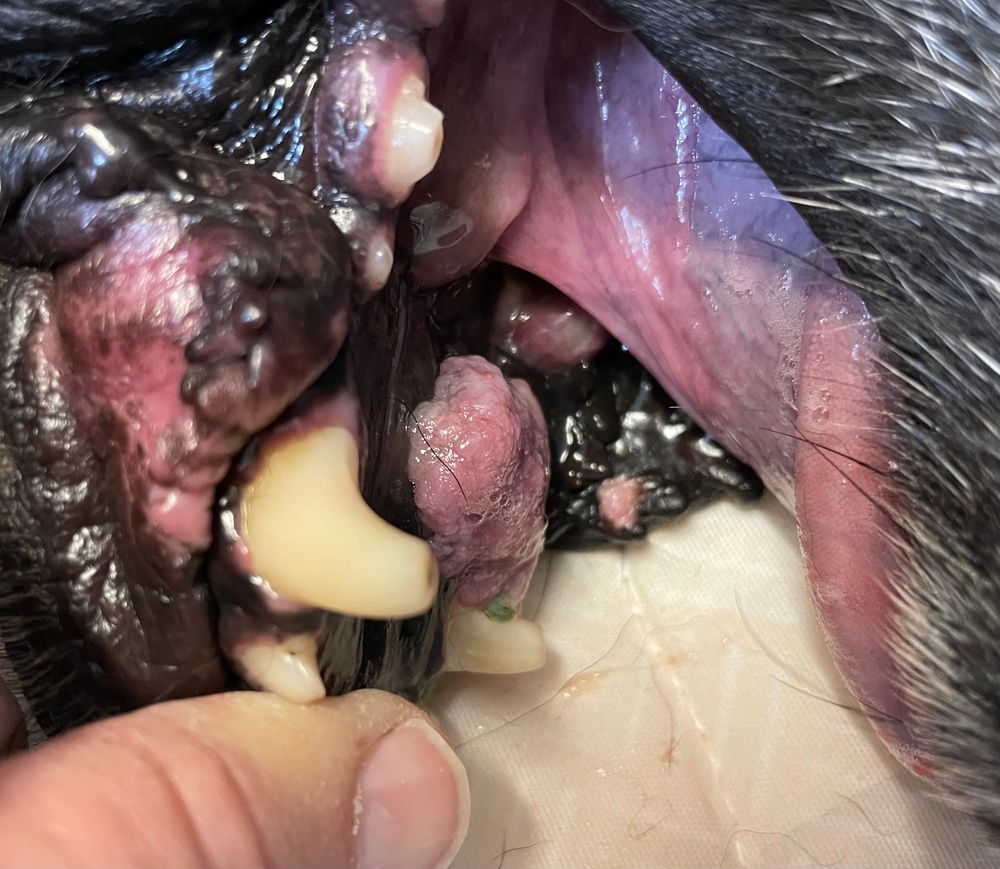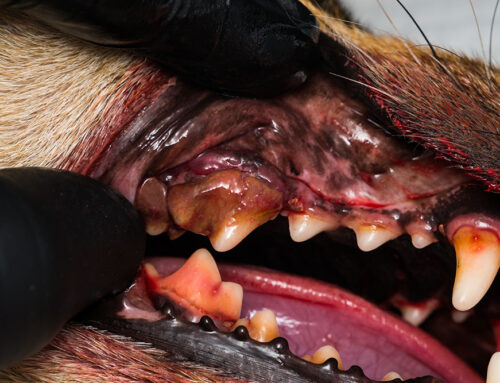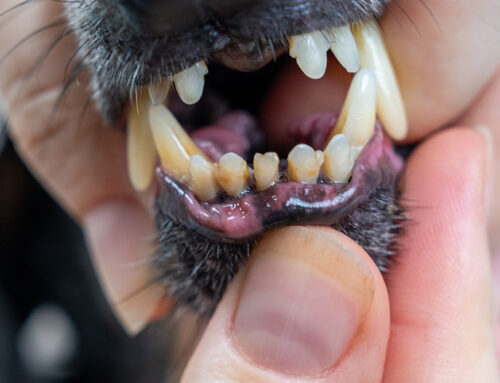Oral cancers in dogs are relatively common, accounting for 6-7% of all canine cancers. Dogs can also develop benign oral tumors that can still significantly damage oral soft tissues and jaws. By knowing the signs to watch for in your dog, you can catch oral tumor development early, and provide your pooch with the best prognosis. Our North Bay Veterinary Dentistry team has some important information about canine oral tumors that you should keep in mind.
Benign oral tumors in dogs
The most common benign oral tumors in dogs are peripheral odontogenic fibromas (aka POF because, what a mouthful!), which can affect any age dog, but typically occur in dogs older than 6. The tumor forms as a firm mass that involves the gingival tissue next to a tooth, and some tumors may have bony centers.
Although POFs do not metastasize (i.e. spread to lymph nodes, or other areas of the body), they can be extensive and/or invasive. Because the tumor develops from the affected tooth’s periodontal ligament, all surrounding oral tissues, including the ligament, must be removed. The great news: complete excision of affected tissues is curative.
Another common benign canine oral tumor is canine acanthomatous ameloblastom (an even bigger mouthful! Call it CAA), which is much more aggressive than a POF and can rapidly invade nearby bone. While this tumor also does not metastasize, the surrounding margins of normal tissue must be removed to prevent recurrence. While this may mean a bigger surgery for your pup, most often they have fantastic recoveries and are cured of the tumor.
Malignant oral tumors in dogs
Malignant oral tumors can develop in any age dog, but more often occur in dogs older than 8. Oral tumors have risk factors for development, and certain breeds, such as golden retrievers, Labrador retrievers, cocker spaniels, poodles, and boxers, are at increased risk of developing oral cancer.
In dogs, the three most common malignant oral tumors are:
- Malignant melanoma — Melanoma is a tumor of melanocytes (i.e., pigment-producing cells) that more typically affects cocker spaniels, chows, Scottish terriers, poodles, golden retrievers, and dachshunds. Oral melanoma may look black or flesh-colored and can develop anywhere in the mouth, including the lips, gums, tongue, and hard palate. These tumors are highly invasive and metastasize readily, so have a guarded to poor prognosis. While surgical resection can extend survival times and may prove curative, recurrence is common. Additional treatments, such as stereotactic radiation therapy and immunotherapy can also extend quality of life.
- Squamous cell carcinoma (SCC) — These tumors are the most common in cats , but they can also pop up under a dog’s tongue, or on the gums, palate or tonsils. These tumors often invade the underlying bone, and can metastasize though they are slower to spread than melanoma. Dogs who develop tumors that originate in the tonsils have a poor prognosis, as these tumors tend to spread to nearby lymph nodes, making removal impossible. Dogs whose tumors can be surgically removed completely can be cured of their cancer, while those that can’t can still have an excellent prognosis using surgery, radiation therapy or both..
- Fibrosarcoma — Fibrosarcomas develop from the fibrous connective tissues, such as tendons, ligaments, cartilage, etc., and can spread to the lungs and lymph nodes. Oral fibrosarcomas typically present as a mass in the mouth, some growing aggressively and others more slowly and require aggressive treatment (i.e., extensive surgery) that removes as much of the tumor as possible. Despite surgery and radiation, this cancer type often comes back in only weeks to months Treatment can extend and improve your dog’s quality of life, and recommendations on what treatment to use are tailored to each pet and each tumor.
Malignant oral tumor signs in dogs include:
- Foul breath
- Excessive salivation
- Bloody or ropey saliva
- Inappetence
- Difficulty chewing or swallowing
- Chewing on one side of the mouth
- Oral mass
- Oral bleeding
- Facial swelling
- Head sensitivity
- Loose teeth
You may also see blood in your dog’s water and food bowls, on their toys, or on their bedding. If your dog’s tumor metastasizes to the lymph nodes (causing swelling) or lungs, they may develop breathing difficulties.
Diagnosing your dog’s malignant oral tumor type may require:
- Blood work
- Urinalysis
- Chest X-rays and/or abdominal ultrasound to check for metastases
- Skull CT scan
- Biopsy of abnormal tissue
- Aspiration of local lymph nodes
Cancer treatment in dogs may employ the same methods as human cancer treatment, but veterinary medicine focuses on quality of life most of all. If we don’t think your pet will have a good quality of life during or after a procedure, we won’t recommend it. Treatment options for dogs with malignant oral tumors include:
- Surgery — To surgically excise an oral tumor, the associated part of the jawbone must often be removed. Pets who lose part of their mandible or maxilla often recover quickly and fully, having good quality of life after surgery healing.
- Radiation therapy — Conventional radiation therapy can be used to remove cancerous cells that remain behind after surgery. However, conventional radiation has low precision and may damage surrounding healthy tissue.
- Stereotactic radiation therapy — Stereotactic radiation therapy, which is a newer, more advanced radiation therapy, can deliver high radiation doses with much greater precision and requires fewer anesthetic events.
- Chemotherapy — Chemotherapy may be indicated for dogs whose tumor has metastasized to other organs or lymph nodes, but is not often a part of oral cancer therapy (many oral tumors have poor reactivity to chemo drugs).
- Melanoma vaccine — Melanoma vaccines can be part of an effective treatment program for oral melanoma tumors. Combining a vaccination regimen with surgical excision and radiation therapy can slow cancer growth or result in remission.
Many clinical signs associated with oral tumors are similar to signs seen with periodontal disease in dogs. Schedule an appointment with the North Bay Veterinary Dentistry team, who can provide an accurate diagnosis for your dog’s bad breath, excessive drooling, and oral pain.






Leave A Comment